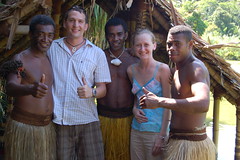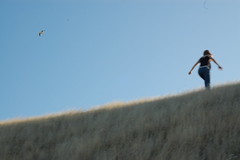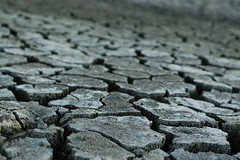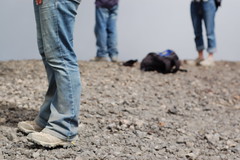Uff, the last week has been a blur of fun activities, amazing sights and freezing cold. Where to start?
Maybe I'll start with our farewell "barbie" in the orchard. The party was, in my opinion, a great success. At 6PM it didn't look like anything, but by 8PM we had a lovely fire going in the fire pit (firewood courtesy of Thomas Bros. Orchard) and burgers, sausages and steaks sizzling on a large grill (also courtesy of Thomas Bros.). We had a steady crew of twelve partiers all night and since it consisted of 2 Czechs, 2 Irishwomen, 2 Hungarians, 1 Slovak, a bunch of Kiwis and Ryan, you can imagine that the thirst for beer was enormous. We ate, drank, sat around the fire and talked all night and the next morning, the scene "after the battle" was truly impressive. The ground as far as eye could see was carpeted with empty beer bottles and cans (I haven't seen such a sight since my college days AND back then it took us a week to collect such a garbage dump!) - all in all, it came out to almost an entire carton of beer per person. A great party, indeed!
The next day was a sunny Sunday and, given the circumstances, you can imagine it took us quite a long time to clean up, pack up, say good-byes and get on the road. It was already 3pm by the time we took off, so in a few hours we had to set up camp in a river gorge somewhere between 2 national parks and in the middle of a lot of wilderness. It was a pretty, but unremarkable spot called Lyell, which was strange, since it was just a little grassy patch of ground in the middle of a river gorge. Soon though, I was shocked to learn that over a hundred years ago this very spot used to be a lively gold-mining town with no less than 5 hotels, a prison, post office and a store(!) The only access to it for a long time was by rafts (imagine early settlers transporting grand pianos and fine English furniture on white water!) and the houses were built on stilts right up against the steep slopes of the gorge. The forest around the town was all cut down and - this I noticed on many other old photographs - the town sat in the middle of a clear-cut waste land - the kind you see today around surface coal mines and such. I have to say that we are a wee bit kinder to our immediate environment these days... Already in the early 20th century Lyell had been a ghost town, vacated after people realized they weren't going to find gold in the river, and now there is nothing left (except for the info boards) to suggest that this dot on the map used to be a lively town. Interesting.
On Monday we reached the Tasman Sea, or the western shore of New Zealand, and headed south to inspect some weird geological phenomena called the Pancake Rocks. The Pancake Rocks are stacks of striped rocks that, of course, resemble very tall stacks of pancakes. They stand on a windy shore, beaten constantly by large and thunderous waves, which makes for a very impressive display, but not good photos. The blowhole that's advertised together with the pancakes is only active during high tide, so it's mostly a disappointment, as it usually doesn't blow when YOU are there. It was a pleasant stop on the way, but I would say that Shantytown, a much less visited but no less fascinating tourist destination some miles down the road, was a much more interesting break from driving.
Shantytown is a living museum of an old gold-mining settlement from the age of the gold rush (NZ, as well as Aussie, had their own gold rush just like the US) - and as far as we could tell, it really used to be a town and Shantytown was its real name. It was great! We visited a real old-times confectioner's store, bank where people used to cash out for their gold, a shoe store, barbershop, a mine, "Chinatown," a hospital with a surgery room, a Freemasons Hall (still in use), fire station AND we took a ride on an actual steam-engine train. (As you can tell, we are not hard people to amuse...) The place was filled with tons of old, cool stuff and you could almost smell the history in the air. You could even dress up as a saloon owner (Ryan) and a bar harlot (me) and have an old-looking photo taken, which, of course, we did because we allow ourselves to be cheesy from time to time. We didn't do the gold panning, however - that seemed like too much work for extra admission AND you didn't get to find any real gold. Maybe next time. Anyway, Shantytown was an interesting history lesson. New Zealand is very much like the US in many ways - in the 1800's NZ was a harsh frontier just like the old American West used to be(minus the rattlesnakes and combative natives). Early settlers had to cut through mountains and raft on wild rivers to start fragile existence in the bush. In the towns that survived, they left behind the cool Victorian frontier hotels that you'd expect John Wayne to walk out of. We see these hotels everywhere and we think that NZ looks just like the American southwest sometimes.
Our next destination, one of our main destinations in the South Island, was the glacier country. At dusk we arrived at a campground that was just at the doorstep of the Southern Alps, the magnificent mountain range that stretches almost along the entire west coast of the South Island. In the morning, we looked over the lake at which we camped and got our first glimpse of the snow-covered peaks. But only a glimpse - the mountains were mostly covered in thick clouds and we hoped that by the time we'd get to them and their glaciers, the clouds will miraculously dissipate and reveal their full splendor.
They didn't. We drove up to Franz Josef Glacier, a little town of lodges and restaurants catering to the busy tourist traffic going to see the Franz Josef and Fox glaciers, fixed some car trouble and went to book a helicopter flight over the glaciers. We were more than ready to spend $300 for 20 minutes of a most amazing view and a landing on the top of the glacier, but, alas, the weather wasn't with us. The last little hole in the clouds that gave us hope closed up within an hour and all helicopter flights were cancelled. Now we had two other options - to walk TO the glacier or book a guided hike ON the glacier, for which we would have had to stay for another day. Hiking on an ancient mountain of ice would have surely been very cool, but we sort of weren't in the mood and we didn't have the adequate attire, so we chose the easy walk instead.
Only about 4km down the road from the town, we reached the carpark and walked with literally hundreds of other tourists to a rocky expanse, from which we had a view of the light blue ice in the distance. In 1750, Franz Josef Glacier reached to about a mile before the carpark, in the 1800's this rocky expanse was filled with ice, in the 1930's this spot was a glacial lake where you could row between icebergs, and now you have to walk on it for about 1km and cross many icy streams to get to the edge of the mountain of ice. But surprisingly, the glacier doesn't only shrink these days. In the 1970's, the glacier was reduced to a tiny trickle that you couldn't even see from this viewpoint. Since then, the ice has expanded again to a considerable size, filling back up the massive valley it had carved so long ago. The barriers at this point didn't deter any of the livelier visitors from the 1km or so of a further walk closer to the ice. So we walked and enjoyed the awesome sight in front of us. (I personally also enjoyed the smell of snow that filled my lungs - this smell and the slight chill on the cheeks was what I longed for in the steamy tropics).
We couldn't take our eyes off the icy cliffs ahead of us - it was such an amazing and unfamiliar sight. The wonderful thing about NZ is not that it has glaciers (and these glaciers, I'm sure, are not the most spectacular or the biggest in the world), but the fact that it has two glaciers that are so easily accessible from the main road. You don't have to be a mountaineer with crampons, thousands of dollars of Goretex gear and years of experience under your belt to see a natural wonder that is quickly disappearing from the world. You can simply walk to it, or book a guided hike on it. You can be just a Jo Schmo driving by in your dilapidated campervan and practically run into it even if you didn't know it was there (since it would be hard to overlook the signs pointing you to it)! It's easier to get to these glaciers than sometimes getting to a public toilets is. Amazing. We didn't touch the ice - we respected the 4 "extreme danger" signs at the end of the walk and enjoyed our view from afar. Beyond this point, only the experienced and the guided were allowed to go. But that was enough for us, we had other places to see...
After Franz Josef, the weather was getting worse. We skipped the neighboring Fox Glacier because of the starting cold drizzle and because we had to be in the ski resort town of Wanaka by that evening. We drove in fog and rain past the Southern Alps whose splendid and snow-covered peaks were all disappointingly hidden in thick cloudage and pushed on in thick rain through Mount Aspiring National Park not concerned about the views we were missing because we couldn't wait to catch up with our backpacker friends Mark and Erica (whom we met on the North Island and who had just recently relocated to Wanaka) - and we were looking forward to a night on a couch!
We spent 2 nights in Wanaka with our friends. We peeled off our long underwear for a good wash, cooked some real breakfast and talked for hours. Wanaka is an Alpine-looking little town filled with lodges and surrounded on all sides by attractive mountains, but it was miserably cold and windy, which prevented us from seeing much of it. We were much more interested in staying warm in Mark and Erica's new apartment (which was pretty cold as it is, since Kiwis do not believe in central heating and we couldn't figure out the electric heater) and in catching up on all the new experiences we've all had, which was A LOT.
From Wanaka we headed, predictably, to Queenstown, the next town on the route to the Fiordland and another cool, adventuresome ski-resort town. Actually, Queenstown is supposed to be an "adventure capital of the world," which we could believe, since its streets are lines with bungy, jet-boating, white-water-rafting, skydiving and everything else booking offices. The town is absolutely awesome - nestled snuggly between much grander, bigger and more formidable mountains than those around Wanaka, filled with fancier hotels and bigger shopping malls...
To be continued next time...
skip to main |
skip to sidebar







About Us

- InfiniteView
- Stara Tura, Slovakia
- Documentary Filmmaker, Nada, and Creative Propagandist, Ryan, detail their exploits in the far corners of the globe.

Link Love


Blog Archive




No comments:
Post a Comment